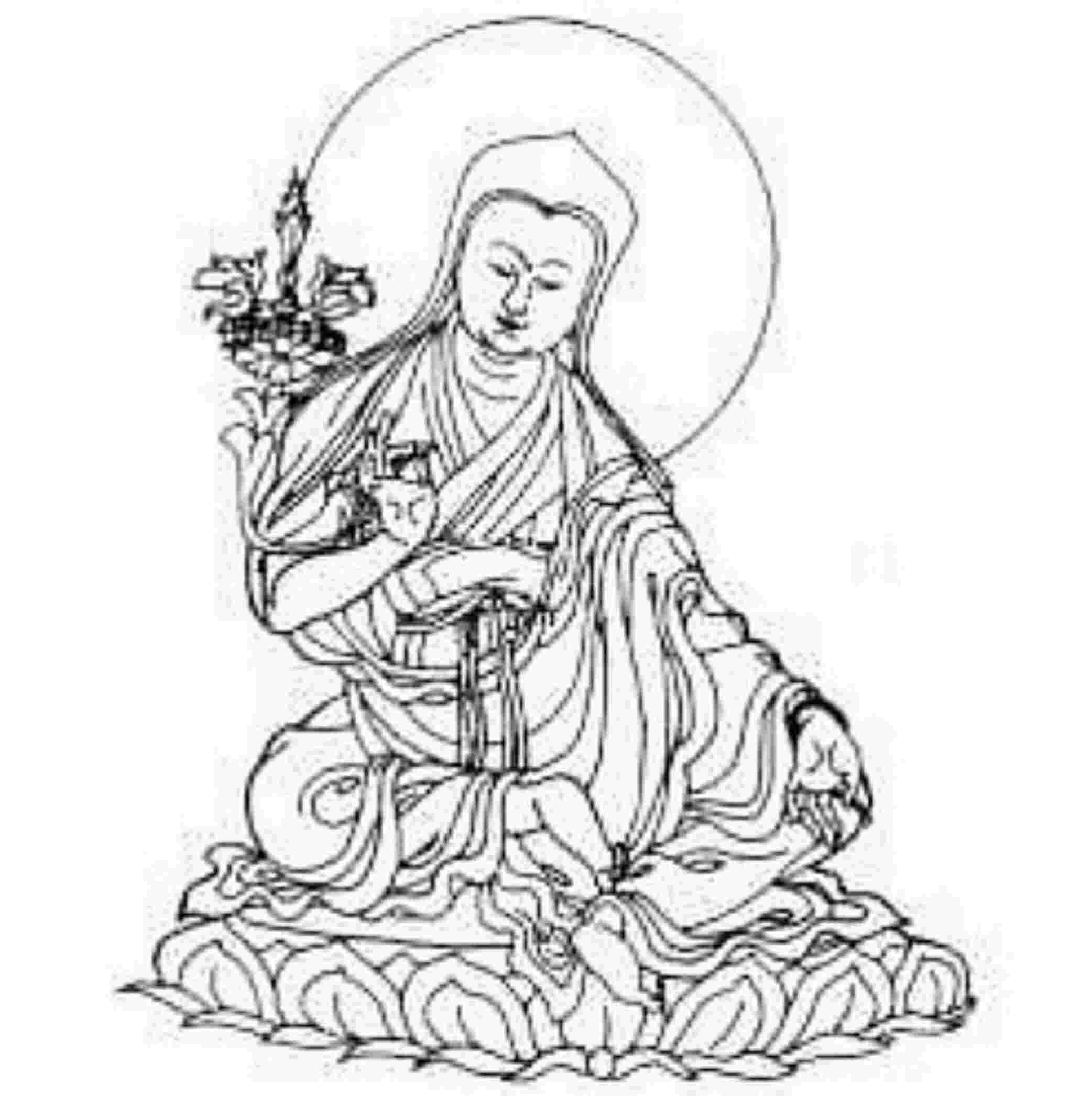Sakya Pandita (1182-1251)
 The greatly learned master
and emanation of
Manjusri, was born to the fourth son of Sachen
Kunga Nyinpo in the water horse year of the third
rajung (cycle). At the time of his birth there
appeared many signs and auspicious omens. At
the time of his birth, he spoke in Sanskrit and by
the age of three Sakya Pandita could read and
speak Sanskrit, Tibetan, Chinese and Mongolian
without having been taught, and within a few years
he was able to recite lengthy works of philosophy
and Tantra by heart.
The greatly learned master
and emanation of
Manjusri, was born to the fourth son of Sachen
Kunga Nyinpo in the water horse year of the third
rajung (cycle). At the time of his birth there
appeared many signs and auspicious omens. At
the time of his birth, he spoke in Sanskrit and by
the age of three Sakya Pandita could read and
speak Sanskrit, Tibetan, Chinese and Mongolian
without having been taught, and within a few years
he was able to recite lengthy works of philosophy
and Tantra by heart.
Through the power of seeing his uncle and mentor
Dragpa Gyaltsen (1147-1216) directly as Manjusri,
Sakya Pandita became possessed with limitless knowledge.
When he was seventeen, Sakya Pandita dreamt that the master
Vasubandhu appeared to him and conferred the knowledge of the
entire Abhidharma system to him directly. At eighteen he dreamt
that Dignaga placed him on a high throne and he was given the
key to all of his teachings, (key of library, de me zon) and when he
awoke he possessed a complete knowledge of logic. Sakya
Pandita studied and learned the teachings of the Kadampa
lineage and was accomplished in all the sciences and medicine,
as well as grammar, poetry, art and music. He composed
numerous lucid philosophical commentaries, and his skill in
debate was unsurpassed.
During one great debate he defeated the most renowned Hindu scholar of this time.
After losing the debate, the Hindu said :"Let us see who is more powerful". He flew into
the sky, but one Lama put a dagger into a rock down he came, thus converting this
master to Buddhism. Afterwards this protector was placed at the border and a rule
made that no Hindu (real Hindu) could enter, and if he did, problems would happen to
him.
As the fame of Sakya Pandita spread, Godan Khan, the Mongol Emperor of China, sent
messengers to Tibet to find the most outstanding lama. They reported that Sakya
Pandita was the most learned master and Milarepa the most accomplished yogi. So the
Emperor invited Sakya Pandita to come to the Mongol court as his spiritual guide.
Remembering his uncle's earlier prophecy, Sakya Pandita journeyed to China at the
age of sixty-five (65). In order to determine the extent of the lama's knowledge, Godan
Khan devised a test. He had his most clever magicians create an illusory temple and
asked Sakya Pandita to consecrate it. But when the lama said the appropriate prayers
and scattered the blessings of rain, the temple became completely real and all could
walk in it. This has been called the Emanation Temple. After this the Khan had great
faith in Sakya Pandita and received many important religious teachings from him. As a
sign of his great reverence for Sakya Pandita, Godan Khan had three exquisite statues
of him cast in gold, silver, and other precious metals. Each was inscribed on the back in
Chinese, Tibetan and Mongolian and personally consecrated by Sakya Pandita. One
remained in China, one in Mongolia and the third was sent to Tibet.
Shortly before he passed away in the Mongol court, Sakya Pandita named his nephew,
Chogyal Phagpa, as his successor and Pandita turned over his bell, dorje, and other
ritual instruments to him. After Sakya Pandita was cremated, many relics were found
and numerous Buddhist images appeared on his bones.
(Ref.: Sakya Tegchen Choling, NEWSLETTER 82 -- pgs
26-27)
 The greatly learned master
and emanation of
Manjusri, was born to the fourth son of Sachen
Kunga Nyinpo in the water horse year of the third
rajung (cycle). At the time of his birth there
appeared many signs and auspicious omens. At
the time of his birth, he spoke in Sanskrit and by
the age of three Sakya Pandita could read and
speak Sanskrit, Tibetan, Chinese and Mongolian
without having been taught, and within a few years
he was able to recite lengthy works of philosophy
and Tantra by heart.
The greatly learned master
and emanation of
Manjusri, was born to the fourth son of Sachen
Kunga Nyinpo in the water horse year of the third
rajung (cycle). At the time of his birth there
appeared many signs and auspicious omens. At
the time of his birth, he spoke in Sanskrit and by
the age of three Sakya Pandita could read and
speak Sanskrit, Tibetan, Chinese and Mongolian
without having been taught, and within a few years
he was able to recite lengthy works of philosophy
and Tantra by heart.